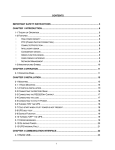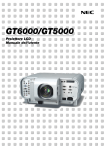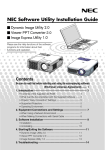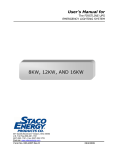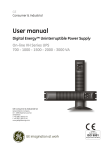Download User manual - GE Digital Energy
Transcript
GE Digital Energy Power Quality User manual Digital Energy™ Uninterruptible Power Supply GT Series UPS 5/6/8/10 kVA GT5000 RT / GT6000 RT GE Digital Energy™ General Electric Company CH – 6595 Riazzino (Locarno) Switzerland T +41 (0)91 / 850 51 51 F +41 (0)91 / 850 52 52 www.GEDigitalEnergy.com imagination at work GT8000 RT / GT10000 RT User manual GT Series - Uninterruptible Power Supply 5/6/8/10 kVA We thank you for selecting a General Electric Digital Energy™ GT Series Uninterruptible Power Supply. Please read these instructions carefully before installation and start-up of the GT Series UPS. Keep this manual in a safe place for future reference. Model: GT Series / Series 1 Date of issue: 09.01.2008 File name: OPM_GTS_XUL_5K0_10K_XUS_V010 Revision: 1.0 Identification No.: Up-dating Revision Concern Date © General Electric Digital Energy™. All rights reserved; reproduction without permission prohibited. The content of this manual may be subject to change without prior notice; no liability can be accepted for any error or omission. The illustrations and plans describing the equipment are intended as general reference only and are not necessarily complete in every detail. modifications reserved 2 User manual GT Series 5/6/8/10 kVA UPS 1.0 (US) Contents 1 IMPORTANT SAFETY INSTRUCTIONS ....................................................................................................... 4 1.1 1.2 1.3 1.4 1.5 1.6 2 INTRODUCTION........................................................................................................................................... 7 2.1 2.2 2.3 2.4 3 Save these instructions.....................................................................................................................................................................4 Safety warnings and symbols .......................................................................................................................................................4 General......................................................................................................................................................................................................5 Transport / storage .............................................................................................................................................................................5 Maintenance and servicing.............................................................................................................................................................6 FCC Compliance Statement............................................................................................................................................................6 Introduction ............................................................................................................................................................................................7 Intended use...........................................................................................................................................................................................7 Warranty ..................................................................................................................................................................................................7 diagram.....................................................................................................................................................................................................7 INSTALLATION............................................................................................................................................. 8 3.1 3.2 3.3 3.4 Package contents ................................................................................................................................................................................8 Installation rules ...................................................................................................................................................................................8 Installation procedure .......................................................................................................................................................................9 3.3.1 3.3.2 3.3.3 3.3.4 3.3.5 3.3.6 3.3.7 3.3.8 3.3.9 Parallel Operation (only for 8/10 kVA) .....................................................................................................................................20 3.4.1 3.4.2 4 Use: normal operation........................................................................................................................................ 25 4.4 Use: status and alarm indications................................................................................................................. 27 4.3.1 4.3.2 4.3.3 Normal operation conditions.......................................................................................................................................................25 Switching off ........................................................................................................................................................................................25 Maintenance Bypass .......................................................................................................................................................................26 4.4.1 4.4.2 4.4.3 4.4.4 4.4.5 4.4.6 4.4.7 4.4.8 4.4.9 4.4.10 4.4.11 4.4.12 On bypass .............................................................................................................................................................................................28 On battery .............................................................................................................................................................................................28 Battery low (end of runtime).........................................................................................................................................................28 Bypass out of limits...........................................................................................................................................................................28 Overload ................................................................................................................................................................................................28 Replace battery ..................................................................................................................................................................................29 Alarm priority.......................................................................................................................................................................................29 Fault mode............................................................................................................................................................................................29 Stand-by ................................................................................................................................................................................................29 Remote Emergency Power Off (REPO) .....................................................................................................................................30 No load shutdown.............................................................................................................................................................................30 Auto Restart .........................................................................................................................................................................................30 4.5 Battery management ......................................................................................................................................... 31 COMMUNICATION .................................................................................................................................... 32 DB9 Communication port .............................................................................................................................................................32 SNMP interface card (option).......................................................................................................................................................32 OPTIONS..................................................................................................................................................... 33 6.1 6.2 7 Start-up of a 5/6 kVA .......................................................................................................................................................................23 Start-up of a 8/10 kVA.....................................................................................................................................................................24 Start-up of a parallel system (8/10 kVA models) ................................................................................................................24 4.3 5.1 5.2 6 Installation of a parallel system .................................................................................................................................................20 Installing the parallel connection ..............................................................................................................................................21 OPERATION................................................................................................................................................ 22 4.1 Operating panel..................................................................................................................................................... 22 4.2 Start-up ..................................................................................................................................................................... 23 4.2.1 4.2.2 4.2.3 5 Tower installation – preparations (all models)........................................................................................................................9 Rack mount installation – preparations (all models) ........................................................................................................10 Connecting internal battery pack (for 5/6 kVA models) ..................................................................................................11 Connecting internal batteries (for 8/10 kVA models only) .............................................................................................12 Connecting additional external batteries (5/6 kVA models)..........................................................................................13 Connecting additional external batteries (8/10 kVA models).......................................................................................14 Connecting interface devices......................................................................................................................................................16 Rear panel.............................................................................................................................................................................................17 Standard installation procedure ................................................................................................................................................18 Optional Power Distribution UNIT .............................................................................................................................................33 6.1.1 6.1.2 5/6 kVA PDUs.......................................................................................................................................................................................34 8/10 kVA PDUs ....................................................................................................................................................................................34 Extended Runtime ............................................................................................................................................................................34 MAINTENANCE .......................................................................................................................................... 35 7.1 7.2 7.3 7.4 Safety ......................................................................................................................................................................................................35 General...................................................................................................................................................................................................35 Recycling the UPS at the end of service life.........................................................................................................................35 Batteries.................................................................................................................................................................................................36 7.4.1 7.4.2 7.5 Internal battery replacement (for 5/6 kVA models)...........................................................................................................37 Internal battery replacement (for 8/10 kVA models) ........................................................................................................38 Power unit maintenance...............................................................................................................................................................39 7.5.1 7.5.2 Power unit replacement (for 5/6 kVA models) .....................................................................................................................39 Power unit replacement (for 8/10 kVA models) ..................................................................................................................39 8 TROUBLESHOOTING................................................................................................................................. 40 9 SPECIFICATIONS ....................................................................................................................................... 41 modifications reserved 3 User manual GT Series 5/6/8/10 kVA UPS 1.0 (US) 1 IMPORTANT SAFETY INSTRUCTIONS 1.1 SAVE THESE INSTRUCTIONS This manual contains important instructions that should be followed during installation and maintenance of the UPS. It also gives all necessary information about the correct use of the UPS. Before attempting to install and start up the UPS, carefully read this manual. Keep this manual next to the unit for future references. Full understanding of and compliance with the safety instructions and warnings contained in this manual are the ONLY CONDITIONS to avoid any dangerous situation during installation, operation and maintenance work, and to preserve the maximum reliability of the UPS system. GE refuses any responsibility in case of non-observance, unauthorized alterations or improper use of the delivered UPS. While every care has been taken to ensure the completeness and accuracy of this manual, GE accepts no responsibility or liability for any loss or damage resulting from the use of the information contained in this document. This document shall not be copied nor reproduced without the permission of GE. Due to technical improvements, some of the information contained in this manual may be changed without notice. The instructions in this manual are for UPS models GT5000 RT, GT6000 RT, GT8000 RT and GT10000 RT. Check your model number by looking at the top cover of your UPS. Any difference in instructions is clearly indicated in the text (for instance ‘GT10000 RT’). 1.2 SAFETY WARNINGS AND SYMBOLS Safety warnings The text of this manual contains warnings to avoid risk to persons and to avoid damages to the UPS system and the supplied critical loads. Do not proceed beyond these warnings if you do not fully understand and/or are not able to meet the mentioned conditions. The non-observance of the warnings reminding hazardous situations could result in human injury and equipment damage. Please pay attention to the meaning of the following warnings and symbols. WARNING! Refers to procedures or operations which, when not correctly performed, could cause personal injury or serious damage to the system. NOTE Warns the user about important operations or procedures described in this manual. Safety Symbols CAUTION The product may be in danger: when procedures or operations are not correctly performed, damage to the product may be the result. DANGER OF ELECTRICALLY LIVE PARTS Related to all situations with potentially hazardous voltage. modifications reserved 4 User manual GT Series 5/6/8/10 kVA UPS 1.0 (US) 1.3 GENERAL DANGER! RISK OF ELECTRIC SHOCK. The UPS has an internal battery supply with a nominal voltage of 144Vdc / 288Vdc. Some of the parts of the UPS are necessarily under a hazardous voltage. Do not open the unit; there are no user serviceable parts inside. The appliance outlets and output terminals may be electrically live, even when the UPS is disconnected from the mains. CAUTION There may be damage to the equipment if procedures and practices are not strictly observed and followed. 1.4 TRANSPORT / STORAGE NOTE Check for sufficient floor and elevator loading capacity. Move the UPS and the battery pack in its original package to the final destination room. Do not stack other package on top. WARNING! Pay attention to the HEAVY WEIGHT of the UPS when downloading the UPS from the pallet! Never try to lift the unit by yourself! • No liability can be accepted for any transport damage when the equipment is shipped in non-original packaging. • Store the UPS in a dry location with the batteries in a fully charged state. Storage temperature must be within -20 +45 °C (-4°F and 113°F). If the unit is stored for a period exceeding 3 months, optimal battery lifetime is obtained if the storage temperature does not exceed 30°C (86°F). • If the unit is stored for an extended period of time, the batteries must be recharged periodically. Connect the unit to a wall outlet and recharge the batteries for 24 hours: - if the storage temperature is within -20 and +30°C (-4°F and 86°F): every 6 months, - if the storage temperature is within -20 and +45°C (-4°F and 113°F): every 3 month. CAUTION In case of storage, pay attention to: modifications reserved 5 User manual GT Series 5/6/8/10 kVA UPS 1.0 (US) 1.5 MAINTENANCE AND SERVICING • A battery can present a risk of electrical shock and high short circuit current • Never dispose of batteries in a fire: they may explode • Do not open or mutilate batteries: their contents may be extremely toxic. If exposed to electrolyte, wash immediately with plenty of water • The batteries must be disconnected during maintenance or service work. • When replacing the batteries, use only the same type and size battery. • The following precautions should be observed when working on batteries: - Remove watches, rings or other metal objects. - Use tools with insulated handles. - Wear rubber gloves and boots. - Do not lay tools or metal parts on top of batteries. - Disconnect charging source prior to connecting or disconnecting battery terminals. - Determine if the battery is inadvertently grounded. If inadvertently grounded, remove source of ground. Contact with any part of a grounded battery can result in electrical shock. The likelihood of such shock will be reduced if such grounds are removed during installation and maintenance. • Avoid charging in a sealed container. NOTE Do not attempt to service the UPS unless you have had proper training. Refer all maintenance and servicing, except replacement of the batteries and plug-in cards, to properly qualified, skilled and competent service personnel. Qualified, skilled personnel are persons who (because of their training, experience, and position as well as their knowledge of appropriate standards, regulations, health and safety requirements and working conditions) are authorized to be responsible for the safety of the equipment, at all times whilst carrying out their normal duties and are therefore aware of, and can report, possible hazards (observe IEC 60364 and national wiring regulations and accident prevention rules). 1.6 FCC COMPLIANCE STATEMENT Note: This equipment has been tested and found to comply with the limits for a Class A digital device, pursuant to Part 15 of the FCC Rules. These limits are designed to provide reasonable protection against harmful interference when the equipment is operated in a commercial environment. This equipment generates, uses and can radiate radio frequency energy and, if not installed and used in accordance with the instruction manual, may cause harmful interference to radio communications. Operation of this equipment in a residential area is likely to cause harmful interference in which case the user will be required to correct the interference at their own expense. Modifications not expressly approved by the manufacturer could void the user’s authority to operate the equipment under FCC rules. modifications reserved 6 User manual GT Series 5/6/8/10 kVA UPS 1.0 (US) 2 INTRODUCTION 2.1 INTRODUCTION The GE Digital Energy™ GT Series UPS, a truly on-line uninterruptible power supply, protects your equipment from all forms of power interference, including complete power failures. 2.2 INTENDED USE Uninterruptible Power Supplies (UPS) are designed to protect sensitive electronic equipment such as computers and telecommunications equipment from all forms of power interference. CAUTION! DO NOT plug household appliances such as electric heaters, toasters or vacuum cleaners into the UPS. The UPS output is intended to be used only for electronic loads such as computers and telecommunications equipment. The technical data as well as information concerning connecting requirements can be found on the rating label and in this document and shall be strictly observed. 2.3 WARRANTY GE Digital Energy™ warrants that the standard products will be free of defects in materials and workmanship for a period of twenty-four (24) months after seller’s shipment date. NOTE This warranty does not cover failures of the product that result from incorrect installation, misuse, alterations by persons other than authorized agents, or abnormal operating conditions. 2.4 DIAGRAM EMI: Input filter with surge suppression, radio frequency and electromagnetic interference filter. BF: Back-feed protection. PFC: AC-DC converter with power factor correction. BC: Battery charger. DCC: DC-DC converter. INV: Inverter. BYP: Bypass switch. MBY: Manual bypass switch. modifications reserved fig. 2.4 7 User manual GT Series 5/6/8/10 kVA UPS 1.0 (US) 3 INSTALLATION 3.1 PACKAGE CONTENTS 8/10 kVA model shipping box contains: • 3 front bezels • 3 top bezels • 6 support stands parts • 2 internal battery brackets • 2 rack mount handles • 1 screw set – 1 display sticker • 1 paralleling cable • 1 RS232 cable, 2 ferrite beads • 1 CD ROM (Software tool) • This Operating Manual 5/6 kVA model shipping box contains: • 2 front bezels • 2 top bezels • 6 support stands parts • 2 rack mount handles • 1 screw set – 1 display sticker • 1 RS232 cable, 2 ferrite beads • 1 CD ROM (Software tool) • This Operating Manual Inspect the UPS for damage after unpacking. If any damage is present please immediately notify the carrier and place of purchase. NOTE The internal battery packs are shipped separately, see section 3.3.3 and 3.3.4 for the installation details WARNING! In case of recognizable damage: DO NOT connect any voltage to the unit DO NOT put the unit into operation 3.2 INSTALLATION RULES IMPORTANT Before making any connection and switching on the GT Series UPS, please check the following conditions: • All electrical connections are to be realized by qualified skilled personnel only. • To avoid potential health risks, electrical components should not be mechanically damaged or destroyed. Do not touch electronic components. They may be electrostatic sensitive and are for that reason easily damaged due to improper handling. • Avoid locations that are excessively humid, near water, near heat sources or in direct sunlight. It is important that the unit has adequate ventilation. Maintain air movement around and through the unit. Do not block the air vents. • The ambient temperature should not exceed 40°C (104°F). Optimal battery lifetime is obtained if the ambient temperature does not exceed 30°C (86°F). • Avoid spilling liquids or dropping any foreign object into the UPS. • The UPS should only be powered from a two phase, four wires AC source equipped with neutral and earth connection. Your mains supply is 100 - 127 Volts (Line-N) and 60 Hz (if the mains frequency is 50Hz, the output frequency of the UPS can be changed, see note in section 4.4.4). • The total power demand of the connected equipment does not exceed the rated output power of the GT Series UPS (chapter 9 contains the ratings). • To reduce risk of fire a disconnection switch should be installed for input and output circuit, connect only to over-current protection branch circuit rated in accordance with the National Electric Code, ANSI/NFPA 70, see following table: UPS model GT5000 RT / GT6000 RT GT8000 RT / GT10000 RT Branch protection 30A slow 60A slow CAUTION To reduce risk of fire, connect the UPS only to a circuit provided with fuse values according to the above. modifications reserved 8 User manual GT Series 5/6/8/10 kVA UPS 1.0 (US) 3.3 INSTALLATION PROCEDURE The UPS can be used in a stand alone tower format using the two supporting stands (section 3.3.1), or can be mounted in a 19 inch rack using the mounting brackets (section 3.3.2). Proceed with the corresponding section, and then connect internal batteries (section 3.3.3 fro 5/6 kVA models and section 3.3.4 for 8/10 kVA models). All required items are included in the delivery, except rails – available as rail kit option. NOTE The UPS output sockets are live as soon as the UPS is connected to the main power supply, even if the UPS has not been switched on via the front panel. 3.3.1 Tower installation – preparations (all models) 1. On 5/6 kVA models align terminals on the backside of the PDU with UPS ones and slide PDU in the UPS (fig. 3.3.1.a). 2. Assemble the plastic support stand and place them in the desired position (2, fig. 3.3.1.b / 3.3.1.c). 5/6 kVA fig. 3.3.1.a 5/6 kVA 3. Place the cabinet upright in to the plastic support stand and mount top covers (3, fig. 3.3.1.b / 3.3.1.c). 4. Attach the display sticker (4, fig. 3.3.1.b / 3.3.1.c). The GT Series UPS is now ready for further connection: proceed with internal battery connection. fig. 3.3.1.b 8/10 kVA fig. 3.3.1.c modifications reserved 9 User manual GT Series 5/6/8/10 kVA UPS 1.0 (US) 3.3.2 Rack mount installation – preparations (all models) 1. On 5/6 kVA models align terminals on the backside of the PDU with UPS ones and slide PDU in the UPS (fig. 3.3.1.a). 2. Install the rack mount handles that came with the unit using the provided screws (2, fig.3.3.2.b / 3.3.2.c). 3. Install the UPS into a 19’ rack. The UPS cabinet must be supported by an (optional) rack mount kit, do not mount it by using the mounting brackets only. 5/6 kVA fig. 3.3.2.a 5/6 kVA fig. 3.3.2.b 8/10 kVA fig. 3.3.2.c NOTE Please consider the weight of the UPS (see section 9) prior to installation to ensure the rack and floor are capable of supporting the weight. For rack installation we recommend that the UPS is placed in the lower section of the rack. Fit the unit and the battery into the rack cabinet with the help of a second person. fig. 3.3.2.d The GT Series UPS is now ready for further connections. Please proceed internal battery connection. modifications reserved 10 User manual GT Series 5/6/8/10 kVA UPS 1.0 (US) 3.3.3 Connecting internal battery pack (for 5/6 kVA models) The internal battery pack is shipped separately from the UPS cabinet. It has to be mounted inside the unit after UPS installation. Please proceed with the following steps: 1. Unpack the battery pack from its carton box. 2. Place the battery pack in front of the battery compartment, aligning the rear connector to the front panel (2, fig. 3.3.3.a). 3. Slide the battery pack into the battery compartment until the rear connector is plugged with the UPS internal DC socket. 5/6 kVA fig. 3.3.3.a 4. Fix the battery cover by tightening screws (4, fig. 3.3.3.b). 5. Mount the front panels by pushing the plastic part into the appropriate holes (5, fig. 3.3.3.c). 6. Proceed with the UPS preparation. 5/6 kVA fig. 3.3.3.b 5/6 kVA fig. 3.3.3.c modifications reserved 11 User manual GT Series 5/6/8/10 kVA UPS 1.0 (US) 3.3.4 Connecting internal batteries (for 8/10 kVA models only) The internal battery packs are shipped separately from the UPS cabinet. They have to be mounted inside the unit after the UPS installation. Please proceed with the following steps: 1. Unpack the 2 battery packs from their carton box. 2. Place the battery packs side by side in the battery compartment (2, fig. 3.3.4.a). 3. Fix the 2 battery brackets with the screw set to hold battery packs into the cabinet (3, fig.3.3.4.a). 4. Connect the UPS DC connectors of each battery pack (4, fig.3.3.4.a). 5. Fix the battery grille in front of the battery compartment with 3 screws (5, fig.3.3.4.b). 6. Mount the front panels by pushing the plastic part into the appropriate position (6, fig. 3.3.4.c). 7. Proceed with the UPS preparation. 8/10 kVA fig. 3.3.4.a 8/10 kVA fig. 3.3.4.b 8/10 kVA fig. 3.3.4.c modifications reserved 12 User manual GT Series 5/6/8/10 kVA UPS 1.0 (US) 3.3.5 Connecting additional external batteries (5/6 kVA models) The additional external battery pack connects to the UPS in the same way whether the UPS is being used in tower or rack mount format. When used in tower format, the UPS and additional battery packs can be mounted together in one set of mounting support stands (fig.3.3.5.a). Additional support stands are shipped with battery cabinet. Connect the cable provided with the battery between UPS and battery pack – plug it into the UPS battery socket and the nearest battery connection socket on the battery pack (fig.3.3.5.b). At first start up the value of the total battery capacity has to be set with the UPS Monitoring software. 5/6 kVA 5/6 kVA fig. 3.3.5.a fig. 3.3.5.b NOTE If further battery packs are used, they connect via the previous battery pack. Thus, the cable provided is attached via the nearest socket connection on the existing battery cabinet (fig. 3.3.5.c). 5/6 kVA fig. 3.3.5.c NOTE When the UPS is connected to the mains, and the battery pack is connected to the UPS, the batteries start charging. For best results, allow the UPS to recharge the batteries during a period of approx. 8 hours. It is acceptable to use the UPS without first charging the battery, but the runtime may be reduced. modifications reserved 13 User manual GT Series 5/6/8/10 kVA UPS 1.0 (US) 3.3.6 Connecting additional external batteries (8/10 kVA models) In case of additional external battery packs, batteries are shipped separately from the battery cabinet. They have to be mounted inside the cabinet after battery installation. Please proceed with the following steps: 1. Unpack the 2 battery packs from their carton box. 2. Place the battery packs side by side in the battery compartment (2, fig. 3.3.6.a). 3. Fix the 2 battery brackets with the screw set to hold battery packs into the cabinet (3, fig. 3.3.6.a) 4. Connect the DC connectors of each battery pack (4, fig. 3.3.6.a). 5. Fix the battery grille in front of the battery compartment with 3 screws (5, fig. 3.3.6.b). 6. Mount the 2 battery front covers. (6, fig. 3.3.6.b). 8/10 kVA fig. 3.3.6.a 8/10 kVA fig. 3.3.6.b The additional external battery pack connects to the UPS in the same way whether the UPS is being used in tower or rack mount format. When used in tower format, the UPS and additional battery packs can be mounted together in one set of mounting support stands (fig.3.3.6.c). Connect the cables provided with the battery between UPS and battery pack – plug them between UPS sockets and nearest sockets on the battery pack (fig.3.3.6.d). The connectors and sockets are keyed and can be plugged only in correct position. At first start up the value of the total battery capacity has to be set with the UPS Monitoring software. 8/10 kVA 8/10 kVA fig. 3.3.6.c modifications reserved fig. 3.3.6.d 14 User manual GT Series 5/6/8/10 kVA UPS 1.0 (US) NOTE If further battery packs are used, they connect via the previous battery pack. Thus, the cable provided is attached via the nearest socket connection on the existing battery cabinet (fig. 3.3.6.e). 8/10 kVA fig. 3.3.6.e NOTE When the UPS is connected to the mains, and the battery pack is connected to the UPS, the batteries start charging. For best results, allow the UPS to recharge the batteries during a period of approx. 8 hours. It is acceptable to use the UPS without first charging the battery, but the runtime may be reduced. modifications reserved 15 User manual GT Series 5/6/8/10 kVA UPS 1.0 (US) 3.3.7 Connecting interface devices The UPS is equipped with two interface ports: a DB9 communication port and an SNMP card slot (see section 3.3.8). Prepare the included serial communication cable (for DB9 communication port connection) or the network cable (for SNMP communication connection) as follows: 1. Choose from the 2 provided ferrite beads the smaller one for serial communication and the bigger one for SNMP communication. 2. Place the cable part that is close to the UPS connector inside the ferrite bead. For SNMP communication twist it once around the ferrite and place the second winding also inside the ferrite bead (fig 3.3.7.a / 3.3.7.b). 3. fig. 3.3.7.a Close the ferrite bead such that the cable remains inside it (fig. 3.3.7.a / 3.3.7.b). fig. 3.3.7.b You can now connect the DB9 port to a computer by connecting the previously prepared serial cable (fig. 3.3.7.c / 3.3.7.d). Additional signals can be read from the serial connector. See section 5.1 for more information. Open the SNMP slot by removing the two screws and the cover, then pull in the easy installation SNMP Card and connect previously prepared network cable (fig. 3.3.7.e / 3.3.7.f). See section 5.2 for more information. 5/6 kVA 5/6 kVA fig. 3.3.7.d fig. 3.3.7.e 8/10 kVA 8/10 kVA fig. 3.3.7.f modifications reserved fig. 3.3.7.g 16 User manual GT Series 5/6/8/10 kVA UPS 1.0 (US) 3.3.8 Rear panel Rear Panel 5/6 kVA: Unit with standard Power Distribution Unit: 1. Input / output terminals (see section 3.3.9) 5/6 kVA 2. External battery connector 3. Output breaker: 2pole, 30A/250Vac 4. Fans 5. SNMP card slot 6. DB9 communication port 7. Additional ground connector fig. 3.3.8.a 8. REPO contacts (see section 4.4.10) Unit with Optional PDU (see section 6.6.1) 5/6 kVA 9. Input breaker: 2pole, 30A/250Vac 10. Maintenance Bypass (Optional Power Distribution Unit) fig. 3.3.8.b Rear Panel 8/10 kVA: 1. Input/Output terminals (see section 3.3.9) 8/10 kVA 2. Input breaker: 2pole, 60A/250Vac 3. Maintenance Bypass (see section 4.3.3) 4. Output breaker: 2pole, 60A/250Vac 5. External battery connectors 6. SNMP card slot 7. DB9 Communication port 8. Fan Module 9. REPO Contacts (see section 4.4.10) 10. Parallel ports (see section 3.4.2) fig. 3.3.8.c modifications reserved 17 User manual GT Series 5/6/8/10 kVA UPS 1.0 (US) 3.3.9 Standard installation procedure NOTE Ensure that the UPS is isolated prior to installation; no live input source may be connected to the UPS during the installation procedure. Open all the input/output switches/breakers on the power distribution and ensure no one is able to close them during this installation step. 1. In case of Optional Distribution Unit please follow instruction at section 6.1, otherwise proceed with step 2. 2. Remove the terminal cover (fig. 3.3.9.a / 3.3.9.b). 3. Punch out the appropriate holes in the terminal cover. Secure the input/output cables using glands, according to fig. 3.3.9.c. 5/6 kVA fig. 3.3.9.a 4. Input. Connect the mains supply wires to the terminals “L1-L2” (Line) and “N” (Neutral) and the ground wire to terminal “ ”. Ground connection is essential! (fig. 3.3.9.d). 5. Output. Connect the load wires to the terminals “L1-L2” (Line) and “N” (Neutral) and the ground wire to terminal “ ”. Ground connection is essential! (fig. 3.3.9.d). 8/10 kVA fig. 3.3.9.b fig. 3.3.9.c NOTE Localize on figure 3.3.9.d proper terminals based on the desired input/output voltage. For 8/10 kVA models use 6 AWG 75°C (167°F) copper wires, 22 lb-in fixation torque force. For 5/6 kVA models use 10 AWG 75°C (167°F) copper wires, 20 lb-in fixation torque force. 5/6 kVA 8/10 kVA fig. 3.3.9.d modifications reserved fig. 3.3.9.e 18 User manual GT Series 5/6/8/10 kVA UPS 1.0 (US) 6. Re-install the terminal cover (fig. 3.3.9.e). 7. In case of external batteries, ensure the battery cable is connected between the battery cabinet and the power unit. (see 3.3.5 / 3.3.6). 8. Connect the utility power to the UPS. 9. For a quick start proceed with section 4.2.1. 5/6 kVA fig. 3.3.9.f 8/10 kVA If parallel-operating units will be installed, please proceed with section 3.4. Otherwise, proceed with section 4. fig. 3.3.9.g NOTE The UPS output sockets are live as soon as the UPS is connected to the mains, even if the UPS has not been switched on via the front panel. For 5/6 kVA models an additional ground connection is required (main ground can be removed with the PDU). Connect the UPS case to the nearest available ground connection with an 8 AWG (10 mm2) copper wire (see fig. 3.3.9.h). 5/6 kVA fig. 3.3.9.h modifications reserved 19 User manual GT Series 5/6/8/10 kVA UPS 1.0 (US) 3.4 PARALLEL OPERATION (ONLY FOR 8/10 KVA) The paralleling cable delivered with each UPS allows you to connect up to 3 UPS together in a parallel system. NOTE The units connected in parallel must be the same power rating (i.e. 8 kVA-8 kVA not 8 kVA-10 kVA) and must have the same output voltage setting (i.e. 120V-120V not 120V127V). Before starting up a parallel system be sure that the output terminals on all UPS are connected in the same way (see section 3.3.9, fig. 3.3.9.d). 3.4.1 Installation of a parallel system 1. 2. 3. 4. 5. All inputs of the UPS must be supplied from the same phase. Be sure that L1 / L2 / N correspond on all the units of the parallel system. All inputs have to be protected individually by fuses. The values of these fuses should correspond to the values mentioned in section 3.2. All outputs must be connected together, supplying the load. It is advised to install switches (S 1, 2, 3 fig 3.4.1) in the output wiring, in order to be able to isolate a unit from the remaining system for service and maintenance purposes. Use insulated copper input and output wiring, rated 90°C (194°F) wire size based on the ampere capacities given in Tables 310-16 of the National Electrical code, ANSI/NFPA 70-2008. The length of all input cables from the input junction (Li, fig. 3.4.1) to the UPS inputs should be equal. The same applies to the cables from the outputs to the output junction (Lo, fig. 3.4.1). The minimum length of the input as well as the output cables is 3 meters. The overall system load may not exceed 100% load of a single UPS in the configuration without the addition of an external maintenance bypass. fig. 3.4.1 modifications reserved 20 User manual GT Series 5/6/8/10 kVA UPS 1.0 (US) 3.4.2 Installing the parallel connection NOTE Ensure that the UPS is isolated prior to installation; no live input source may be connected to the UPS during the installation procedure. Open all the input/output switches/breakers on the power distribution and ensure no one is able to close them during this installation step. 8/10 kVA 1. Localize the parallel port on the rear side of the unit (fig. 3.4.2.a) 2. Connect the DB 15 parallel cable provided with the UPS to the parallel port (fig. 3.4.2.b) and tighten it. fig. 3.4.2.a 8/10 kVA 3. One cable connects two UPS in parallel. To connect a third UPS into the parallel system, repeat the process as above (fig. 3.4.2.d) fig. 3.4.2.b 8/10 kVA 4. For a quick start of the system proceed with section 4.2.3 5. Each UPS needs a different configuration of the DIPswitch as identification of unit in the parallel system (fig. 3.4.2.c). fig. 3.4.2.c 8/10 kVA fig. 3.4.2.d modifications reserved 21 User manual GT Series 5/6/8/10 kVA UPS 1.0 (US) 4 OPERATION 4.1 OPERATING PANEL fig. 4.1: operating panel switch / LED ‘UPS off’ switch 1 2 ‘UPS on’ switch 3 4 LED ‘mains available’ (green) LED ‘battery’ (yellow) 5 6 LED ‘operation’ (green) LED ‘bypass’ (yellow) 7 8 LED ‘alarm’ (red) LED bar ‘runtime capacity’ 9 LED bars ‘load’ modifications reserved main function switches the UPS from normal operation to bypass and from bypass or battery to standby. switches on the UPS, starts quick battery test (see section 4.5), mute the buzzer. indicates availability of power mains. on in case of battery operation: the mains power fails, and the internal batteries supply the required power until either they are depleted or mains power returns. on when the output is supplied by the UPS (inverter). on when the UPS operates in bypass mode: the incoming mains power is channeled directly to the load. Blinks if the input voltage is out of bypass tolerance (see section 4.4.4 for more details). on in case of alarm. the remaining available battery runtime for the actual load, in % of the maximum runtime with the actual load. When the alarm LED is on, this bar may show a combination of LEDs, describing the Alarm cause (see 4.4). 1º LED: 2º LED: 3º LED: 4º LED: 5º LED: 0-20% 21-40% 41-60% 61-80% 81-100% green green green green green 1º LED: 2º LED: 3º LED: 4º LED: 5º LED: 0-25% 26-50% 51-75% 76-100% >100% green green green green yellow indicates to what extent the output capacity of the UPS is used by the actual load for each output line (L1 and L2). If e.g. the 25%, 50% and 75% LED are on for Line 1 and the 25% and 50% LED are on for Line 2, the load exceeds 50% of the maximum load for Line 1 and 25% for Line 2. If all 5 LEDs are on the unit operates in overload. As this is an abnormal situation the alarm LED will be on as well. 22 User manual GT Series 5/6/8/10 kVA UPS 1.0 (US) 4.2 START-UP 4.2.1 Start-up of a 5/6 kVA 1. Ensure that all breakers on the unit are off. 2. In case external batteries are used (see section 3.3.5 for battery connection), switch on the battery cabinet circuit breaker (fig. 4.2.1.a). 3. In case optional power distribution unit is used, ensure that the manual bypass switch is turned to “UPS” position (fig. 4.2.1.b). 4. Close all switches and breakers upstream to the UPS. 5. Switch the input circuit breaker placed on the rear side of the unit to position “On” (fig. 4.2.1.d). The “Mains available” LED on the operating panel (see section 4.1) is lighted on. 6. Wait 45 seconds to allow the output voltage to stabilize. 7. Press keypad “UPS on” for 1 second. Within few seconds “operation” LED will be illuminated and “bypass” LED will be extinguished. 8. Close the Output circuit breaker placed on the rear side of the unit (see fig. 4.2.1.c). 9. The unit is now in operation; equipment connected to the UPS can now be switched on. 5/6 kVA fig. 4.2.1.a 5/6 kVA PDU fig. 4.2.1.b 5/6 kVA fig. 4.2.1.c 5/6 kVA fig. 4.2.1.d Load % will be shown on “load” LED bar. modifications reserved 23 User manual GT Series 5/6/8/10 kVA UPS 1.0 (US) 4.2.2 Start-up of a 8/10 kVA 1. Ensure that all breakers on the unit are off. 2. In case of external batteries are used (see section 3.3.6 for battery connection), switch on the battery cabinet circuit breaker (fig.4.2.2.a). 3. Ensure that Bypass circuit breaker (see section 3.3.7) is on “UPS” position (fig.4.2.2.b) or that protection bar is still mounted. 4. Close all switches and breakers upstream to the UPS. 5. Switch the input circuit breaker placed on the rear side of the unit to position “On” (fig.4.2.1.d). The “Mains available” LED on the operating panel (see section 4.1) is lighted on. 6. Wait 45 seconds to allow the output voltage to stabilize. 7. Press keypad “UPS on” for 1 second. Within few seconds “operation” LED will be illuminated and “bypass” LED will be extinguished. 8. Close the Output circuit breaker placed on the rear side of the unit (fig. 4.2.2.c). 9. The unit is now in operation; equipment connected to the UPS can now be switched on. 8/10 kVA fig. 4.2.2.a 8/10 kVA fig. 4.2.2.b 8/10 kVA fig. 4.2.2.c 8/10 kVA Load % will be shown on “load” LED bar. fig. 4.2.2.d 4.2.3 Start-up of a parallel system (8/10 kVA models) 1. 2. 3. 4. Ensure that all breakers on all the units of the system are off. In case external batteries are used, switch on each circuit breaker (fig. 4.2.1.a / 4.2.2.a). Ensure that all manual bypass switches are turned to “UPS” position (fig. 4.2.1.b / 4.2.2.b). Close all switches and breakers upstream to all UPS of the system. 5. Switch to position “on” the output circuit breaker on all UPS in sequence (fig. 4.2.1.c / 4.2.2.c). 6. Switch to position “On” the input circuit breaker on all UPS in sequence (fig. 4.2.1.d / 4.2.2.d). 7. Wait 45 seconds to allow the output voltage to stabilize. 8. Press keypad “I” on each UPS for 1 second. Within few seconds LED ‘operation’ will be illuminated and LED ‘bypass’ will be extinguished. 9. The parallel system is now in operation and the connected equipment can now be switched on. The load will be shared between the UPS as shown on the LED bar ‘load’. modifications reserved 24 User manual GT Series 5/6/8/10 kVA UPS 1.0 (US) 4.3 USE: NORMAL OPERATION 4.3.1 Normal operation conditions 1. 2. 3. 4. The mains supply is present and within the tolerance (see chapter 9), and The UPS is on, and The load does not exceed the capacity of the UPS, and The operating temperature is below alarm level. 4.3.2 Switching off 1. Be sure that the load has been shut down in a controlled way. 2. Press keypad “O” (fig. 4.3.2.a) for 1 second to switch the unit to bypass. 3. Press one more time the keypad “O” for 1 second to switch off the unit (fig. 4.3.2.a). fig. 4.3.2.a If electrical isolation is required (e.g. for maintenance purposes) proceed with steps 4-7 below: 5/6 kVA 4. Turn the Output circuit breaker to position “off” (fig. 4.3.2.b / 4.3.2.c). 5. Turn the Input circuit breaker to position “off” (fig. 4.3.2.d / 4.3.2.e). 6. In case of external batteries are connected, switch off the battery cabinet circuit breaker and disconnect battery cabling at the rear side of the UPS. fig. 4.3.2.b 8/10 kVA 7. Open all switches and breakers upstream to the UPS. 8. Remove internal and external battery connections (see section 7.4.1 / 7.4.2) and disconnect additional battery packs. All LED should be out on the front panel; the UPS is shut down. fig. 4.3.2.c 8/10 kVA 5/6 kVA fig. 4.3.2.d modifications reserved fig. 4.3.2.e 25 User manual GT Series 5/6/8/10 kVA UPS 1.0 (US) 4.3.3 Maintenance Bypass It’s possible to bypass the unit for maintenance purpose (with Optional Distribution Unit for 5/6 kVA models, standard for 8/10 kVA models, section 3.3.8). In case of necessity, please proceed with the following steps: 1. Switch the unit on bypass, for 5/6 kVA models by pressing keypad “UPS Off” on the front panel (see section 4.1) for 1 second and for 8/10 kVA models by removing the bypass protection cover (fig. 4.3.3.b). 2. Switch the Maintenance Bypass Switch to “Bypass” position (fig. 4.3.3 a / 4.3.3.b). For 8/10 kVA models remove the bypass lock plate before switching to “Bypass”. 3. Switch the unit off, by pressing keypad “UPS Off” on the front panel (see section 4.1) for 1 second. 4. Open the Output circuit breaker (see section 3.3.8). 5. Open the Input circuit breaker (see section 3.3.8). 6. The unit is now operating in “External Bypass mode” and maintenance can be done. 5/6 kVA fig. 4.3.3.a 8/10 kVA fig. 4.3.3.b NOTE After the UPS is shutdown or in “External Bypass” condition, the residual DC voltage in the unit will be eliminated within 5 minutes. Once the maintenance is executed, recover normal conditions with the following steps: 1. Close the Input circuit breaker (see section 4.2.1 / 4.2.2). 2. Wait 45 seconds to allow the output voltage to stabilize. 3. Press keypad “UPS on” for 1 second (see section 4.1). Within few seconds “operation” LED will be illuminated and “bypass” LED will be extinguished. 4. Switch the unit to bypass, by pressing keypad “UPS Off” on the front panel (see section 4.1) for 1 second. 5. Close the Output circuit breaker (see section 4.2.1 / 4.2.2). 6. Switch the Maintenance Bypass Switch to “UPS” position (fig. 4.3.3.c / 4.3.3.d). For 8/10 kVA models screw the bypass lock plate (fig. 4.3.3.d). 7. Press keypad “UPS On” (see section 4.1) for 1 second. 5/6 kVA fig. 4.3.3.c 8/10 kVA fig. 4.3.3.d Now the UPS protects the load again. modifications reserved 26 User manual GT Series 5/6/8/10 kVA UPS 1.0 (US) 4.4 USE: STATUS AND ALARM INDICATIONS o status indications the operating mode ! low priority alarms abnormal operating situations !! high priority alarms situations in which the actual output voltage of the UPS is no longer guaranteed; immediate action should be taken Indicators on front panel (fig 4.1) Situation o Stand-by (4.4.9) 1-5 o Normal operation (4.3.1) 1-5 0-4 ! Overload warning (4.4.5) 1-5 5 !! Battery not connected (4.5) !! Replace battery (4.4.6) ! Bypass out of limits (4.4.4) o ---1 / 0.5 sec 0-4 ---- 1& 3 0-4 1-5 0-4 On bypass (4.4.1) 1-5 0-4 o On battery (4.4.2) 1-5 0-4 !! Battery low (4.4.3) 1 0-4 !! Fault on bypass ---- 0-5 !! Fault stand-by ---- ---- ---- ---1 / 60 sec ---1/120 sec ---1 / 5 sec ---- Operating modes and corresponding indications, see 4.3.1 - 4.3.2 and 4.4.1 – 4.4.9. ---- : intermittent ⎯⎯ 0–5 mute buzzer : continuous : number of LEDs that can be on, depending on runtime capacity / load bar : press push button ‘I’ briefly modifications reserved 27 User manual GT Series 5/6/8/10 kVA UPS 1.0 (US) 4.4.1 On bypass The UPS is equipped with an automatic bypass switch. This switch automatically transfers the load to the main power supply if the UPS is unable to deliver the demanded output power due to overload or over temperature. If all 5 load LED are illuminated, bypass operation is caused by an overload. If only first runtime LED is illuminated, bypass operation is caused by over temperature (see 4.4.8 tab .1). The UPS will switch back to normal operation when the overload has been removed. When temperature drops below alarm level unit can be switched back to normal operation. If a power failure occurs during bypass operation, the UPS will switch to battery if possible, otherwise output power is lost. 4.4.2 On battery In normal operation conditions, if a main power supply failure occurs, the UPS uses the energy stored in the batteries to supply the load. The runtime capacity LED bar will show the remaining time (see 4.1). For further information about runtime refer to chapter 9, Battery runtime. The UPS will shutdown: • After the batteries have been discharged (automatic restart if enabled), or • If keypad ‘UPS off’ is pressed (restart via front panel required), or • If a ‘UPS shutdown’ command is given by the computer (via UPS monitoring software). Restart depends on the setting of “auto-restart” function (see 4.4.12). 4.4.3 Battery low (end of runtime) If during battery operation the buzzer starts beeping every 5 seconds and the first LED of the battery runtime bar starts blinking the batteries are nearly discharged: the remaining runtime is less than 2 minutes (default setting, adjustable via the UPS monitoring software). Controlled shutdown of any computer equipment is absolutely necessary when this alarm is raised. If the UPS operates at 100% load, the shutdown procedure should be completed within 2 minutes after the ‘battery low’ alarm started. If only part of the output capacity of the UPS is used this period can be longer, with aged batteries this period can be shorter. When the batteries are fully discharged, the UPS is no longer able to supply the connected equipment and eventually output power is lost. 4.4.4 Bypass out of limits The mains voltage or mains frequency is outside bypass tolerance but inside UPS input tolerance (see chapter 9). Bypass operation is inhibited: if for whatever reason the UPS is not able to deliver the required output, output power is lost. If the input frequency is often out of tolerance – during which bypass operation is inhibited and an alarm is generated – it may be useful to disable bypass function (via UPS monitoring software) after which the unit operates as a UPS without automatic bypass switch. NOTE The unit can be used as frequency converter: the input frequency range is 40-70 Hz; the output frequency is selectable 50/60 Hz, via UPS monitoring software. If the unit is used in this configuration, the bypass function is no longer available. 4.4.5 Overload The demanded power exceeds the nominal capacity of the UPS. The “overload warning” alarm occurs when the load exceeds 150% the UPS will immediately switch to bypass, assuming that the conditions for a transfer to bypass are fulfilled. If an overload condition between 110-150% persists, the UPS will also switch to bypass operation. In both conditions the “overload” alarm (see 4.4.8 tab. 1) is generated. During an overload the UPS may automatically switch off within a few minutes (load dependent) and output power is lost: • if a transfer to bypass is inhibited (see section 4.4.4), or • if the bypass function has been disabled (see section 4.4.4), or • if the UPS operates on battery (see section 4.4.2). To avoid these problems, be absolutely certain that the power demand of the protected equipment is within the limits of the UPS. modifications reserved 28 User manual GT Series 5/6/8/10 kVA UPS 1.0 (US) 4.4.6 Replace battery Either the batteries are almost chemically worn out or the battery wiring, including the battery fuse, is faulty. If the batteries are aged, they must be replaced as soon as possible to ensure full protection for your equipment (see section 7.4.1 & 7.4.2). Perhaps the 'replace battery' alarm occurs after a test, which was started immediately after installation or after a power failure. In this case the alarm may be incorrect, as the batteries have been (partly) discharged during transport or storage or during the power failure. For this reason we advise to execute battery test only after 5 hours on line operation with no mains failures. This allows the UPS to recharge the batteries. 4.4.7 Alarm priority ‘General alarm’ comprises a group of alarms; the buzzer behavior indicates the priority of the generated alarm. ON: 1 / 0.5 sec.: 1 / 4 sec.: 1 / 60 sec.: 1 / 120 sec.: Battery not connected (see section 4.5) Overload (see section 4.4.5) General Alarm Battery test failed (see section 4.5) On bypass (see section 4.4.1) 4.4.8 Fault mode The UPS may be in “fault mode” if the following failure occurred: Indicators on Battery Charge Bar Fault Situation LED 1 LED 2 LED 3 LED 4 LED 5 Buzzer !! Charger Over-voltage ---1 / 4 sec !! Output Short Circuit ---1 / 4 sec !! Negative Power ---1 / 0.5 sec !! Overload ---1 / 4 sec !! Over-temperature = continuous - - - - = intermittent !! = high priority In “fault mode”, the UPS is “forced” on bypass or stand-by. After having solved the cause of the fault condition you have to press the ‘UPS off’ button for 0.5 seconds to switch the UPS to normal mode or restart the unit. 4.4.9 Stand-by In stand-by mode the UPS is turned off (output power is lost) and the batteries are being recharged. To put the unit in this condition press for 1 second the ‘UPS off’ switch, the unit switches to bypass. Press one more time ‘UPS off’ switch for 1 second. The unit is now in stand-by mode. Most changes of UPS settings are only possible in bypass or stand-by mode. modifications reserved 29 User manual GT Series 5/6/8/10 kVA UPS 1.0 (US) 4.4.10 Remote Emergency Power Off (REPO) REPO may be created using either normally open or normally closed switch. The unit is shipped with a jumper connected between pin 3 and 4 (fig.4.4.10.a), corresponding to no REPO functionality. In case of connection with a normally open contact, this jumper must be removed and a normally open switch cabling has to be connected between pin 1-2 (fig. 4.4.10). In case of connection with a normally closed contact, the jumper must be shifted between pin 1 and 2, and the normally close switch has to be connected between pin 3 and 4 (fig. 4.4.10). 5/6 kVA 8/10 kVA fig.4.4.10 When REPO is activated the UPS will transfer to stand-by mode (see 4.4.9) and output power is lost. It’s not possible to restart the unit while the REPO is activated, thus, depending on the used switch, the connection must be restored by closing or opening the contact. Press “UPS off” button 2 times within 4 seconds to be able to restart the unit. 4.4.11 No load shutdown If no load shutdown is enabled, the load is less than 5% and in case of utility failure the UPS will switch off avoiding deep discharge of the batteries and output power is lost. “No load shutdown” is disabled as default. It’s possible to enable it via UPS Monitoring Software. 4.4.12 Auto Restart Default enabled “Auto restart” may be disabled via UPS monitoring software. Auto Restart acts after the UPS has been shut down during a mains failure: - if the function is set “enabled”, the UPS will automatically restart when the mains returns - if the function is set “disabled”, a manual restart is required, either as explained in section 4.2.1 / 4.2.2 or via the UPS monitoring software. modifications reserved 30 User manual GT Series 5/6/8/10 kVA UPS 1.0 (US) 4.5 BATTERY MANAGEMENT Maximum battery life and reliability are obtained by the following features: • Battery connection test At start-up the unit performs an automatic test to check that the battery cabling and fuses are properly connected. If the test detects a battery disconnection, the corresponding alarm will be generated (see section 4.4.7). • Quick battery test A quick battery test may be launched to check whether batteries are healthy. To start the test, press ‘UPS on’ button (see section 4.1) for 0.5 seconds when the unit is in “normal operation” conditions (see section 4.3.1). In case of failure the corresponding alarm will be generated (see section 4.4.6 / 4.4.7) • Deep battery test A deep battery test will update the runtime calculation and may be started via the UPS monitoring software. The test will start only if the battery charge level is higher than 90% and the load must be at least 20% of the nominal rating. The runtime calculation will be updated only if the test can run uninterrupted till complete battery discharge. NOTE When executing a deep battery test the available runtime in case of mains failure may be shorter than normal. Don’t execute this test if reduced battery runtime is not acceptable. NOTE It’s possible to reset the battery test, by pressing the ‘UPS off’ switch (see 4.1) for 1 sec. The UPS will switch to bypass mode. modifications reserved 31 User manual GT Series 5/6/8/10 kVA UPS 1.0 (US) 5 COMMUNICATION 5.1 DB9 COMMUNICATION PORT The RS232 port is a plug-in interface port, which enables advanced communication between the UPS and the computer via serial cable (fig. 5.1) and UPS monitoring software. The interface port is already operative in stand-by mode (see section 4.4.9). To change settings of the unit, we strongly recommend to be sure that the unit is in stand-by mode. Some settings can only be changed if the UPS operates in bypass or stand-by mode. NOTE The change of some settings can cause the unit to switch from bypass to standby and output power is lost. For more information regarding possible settings, please refer to the “Help” manual of the UPS monitoring software. 8/10 kVA 5/6 kVA fig. 5.1 5.2 SNMP INTERFACE CARD (OPTION) This card allows the data interface to be connected directly to an Ethernet network. The card is fitted into the SNMP Card slot (8, fig. 3.3.5.a). For more information, please refer to the user manual that comes with the interface card. modifications reserved 32 User manual GT Series 5/6/8/10 kVA UPS 1.0 (US) 6 OPTIONS 6.1 OPTIONAL POWER DISTRIBUTION UNIT A different power distribution unit, equipped with Maintenance Bypass switch, can be installed on the rear side of the unit. To replace the Power Distribution Unit (on 5/6 kVA models) or to place the Optional Power Distribution Unit (on 8/10 kVA models) proceed as follows: 1. Ensure the unit is completely shutdown, with all breakers opened (see section 4.3.2). 2. Disconnect internal batteries (see section 7.4.1 and 7.4.2) and external batteries by removing cabling from UPS DC connector. 3. On 5/6 kVA models remove all power connection cables from the Standard PDU (see section 3.3.9). 4. On 5/6 kVA models loosen the three mounting screws (fig. 6.1.a) of the Standard PDU until it can be removed from the UPS cabinet. On 8/10 kVA models loosen the four mounting screws (fig. 6.1.b) of the PDU cover and remove it. 5. Remove PDU from UPS. 5/6 kVA fig. 6.1.a 8/10 kVA The unit is now ready for new PDU assembly. fig. 6.1.b 6. On 5/6 kVA models align terminals on the backside of the PDU with UPS ones and slide PDU in the UPS (fig. 6.1.c). On 8/10 kVA connect terminals on the backside of the PDU with connections in the PDU tray on the backside of the UPS and slide PDU in to the UPS (fig. 6.1.d). 7. On 5/6 kVA models fix the PDU to the UPS with the three mounting screws (fig. 6.1.c). On 8/10 kVA models fix the PDU to the UPS with the four mounting screws (fig. 6.1.d). 8. 5/6 kVA fig. 6.1.c 8/10 kVA Connect Input / Output terminals and follow standard installation procedure (see section 3.3.9). The unit is now ready to be turned on again. Proceed with section 4.2.1. fig. 6.1.d modifications reserved 33 User manual GT Series 5/6/8/10 kVA UPS 1.0 (US) 6.1.1 5/6 kVA PDUs Model Outlets (NEMA) TB 5-20R T L5-20R L5-30R EN60320 L1-N-G L2-N-G L1-N-G L2-N-G L1-N-G L2-N-G L1-N-G L2-N-G GT PDU A 01* GT PDU A 02 GT PDU A 03 GT PDU A 04 GT PDU A 05 GT PDU A 06 GT PDU A 07 GT PDU A 08 GT PDU A 09 Inlets (NEMA) L6-20R L6-30R L14-30R L1-L2-G L1-L2-G L1-N-L2-G 1 1 TB L14-30P 1 1 2 1 2 2 1 2 1 1 1 1 1 1 1 1 1 L6-20R L6-30R L1-L2-G L1-L2-G 2 2 2 2 2 2 2 1 2 1 2 4 *: No 3 pole 6 ms maximum transfer time manual bypass 6.1.2 8/10 kVA PDUs Outlets (NEMA) Model GT PDU B 01 GT PDU B 02 GT PDU B 03 GT PDU B 04 GT PDU B 05 GT PDU B 06 5-20R T-type L5-20R L1-N-G L2-N-G 4 2 2 2 2 4 2 2 2 2 L1-N-G L2-N-G 2 4 2 1 2 1 2 4 2 2 4 6.2 EXTENDED RUNTIME Extended runtime can be obtained by connecting a separate battery extension pack to the UPS. In this case the UPS must be informed about the new total battery capacity to allow a reliable recalculation of the available runtime (via UPS monitoring software). Depending of the charge condition of the new batteries the new runtime calculations may temporarily be unreliable. Additional batteries increase the recharging time for the unit; all other operational information is the same as for standard models. The following table shows runtimes with up to 3 Battery Packs. 1 Battery Pack is the normal configuration. Unit GT5000 RT GT6000 RT GT8000 RT GT10000 RT modifications reserved Load Internal Batteries 1 Battery Pack 2 Battery Pack 3 Battery Pack 10% 25% 50% 75% 100% 10% 25% 50% 75% 100% 10% 25% 50% 75% 100% 10% 25% 50% 75% 100% 75 min 31 min 14 min 8 min 5 min 75 min 31 min 14 min 8 min 5 min 107 min 40 min 16 min 10 min 6 min 107 min 40 min 16 min 10 min 6 min 156 min 75 min 34 min 22 min 14 min 156 min 75 min 34 min 22 min 14 min 251 min 100 min 39 min 24 min 17 min 251 min 100 min 39 min 24 min 17 min 235 min 115 min 58 min 35 min 25 min 235 min 115 min 58 min 35 min 25 min 333 min 160 min 66 min 41 min 28 min 333 min 160 min 66 min 41 min 28 min 313 min 155 min 82 min 50 min 36 min 313 min 155 min 82 min 50 min 36 min 494 min 225 min 92 min 58 min 41 min 494 min 225 min 92 min 58 min 41 min 34 User manual GT Series 5/6/8/10 kVA UPS 1.0 (US) 7 MAINTENANCE 7.1 SAFETY DANGER When the UPS operates, all parts of the electronics are directly connected to the utility and high voltages are present on all internal parts, including the battery. Even after disconnection from the utility, all parts inside the UPS, including the battery, conduct dangerous voltages (except the COM port outlet). For your safety, only authorized service personnel may remove the cabinet cover. Refer to section 4.3.2 for further details. 7.2 GENERAL The GE Digital Energy GT Series UPS is virtually maintenance free: take care of proper environmental conditions and keep air inlets/outlets free of dust. Please read 3.2. NOTE Apart from battery replacement, refer maintenance and service work to qualified and skilled personnel only. Refer to section 1.2 for further details. 7.3 RECYCLING THE UPS AT THE END OF SERVICE LIFE NOTE This product has been designed to respect the environment, using materials and components respecting eco-design rules. It does not contain CFCs (Carbon Fluorine Chloride) of HCFCs (Halogen Carbon Fluorine Chloride). The batteries contain lead, which is a harmful substance for the environment. Proper disposal or recycling of the batteries is required. Refer to your local codes for disposal requirements. GE Digital Energy™, in compliance with environment protection recommends that the UPS equipment, at the end of its service life, must be recycled conforming to the local applicable regulations. modifications reserved 35 User manual GT Series 5/6/8/10 kVA UPS 1.0 (US) 7.4 BATTERIES The service life of the battery is from 3 to 5 years, depending on the operating temperature and on the number of discharge cycles. As a healthy battery is critical to the performance of the UPS, an automatic quick battery test is performed regularly to ensure failsafe operation (see section 4.5). When the condition of the battery is critical, a 'replace battery' alarm will be activated (see 4.4 and 4.4.6). Replace the batteries as soon as possible. General guidelines: • When replacing the batteries, use all of them of only the same type and size. • Never short the battery terminals. Shorting may cause the battery to burn. When working with batteries remove watches, rings or other metal objects and only use insulated tools. • Avoid charging in a sealed container. • Proper disposal of batteries is required: refer to your local codes for disposal requirements. • Never dispose batteries in fire: they may explode. • Never disassemble or reassemble batteries; their contents (electrolyte) may be extremely toxic. If exposed to electrolyte, wash immediately with plenty of water, if eye contact occurs flush with water and contact a physician. modifications reserved 36 Don’t throw batteries away, treat them as harmful waste User manual GT Series 5/6/8/10 kVA UPS 1.0 (US) 7.4.1 Internal battery replacement (for 5/6 kVA models) In case of battery failure, please proceed with the following steps to replace that: NOTE During battery replacement the UPS will not be able to support the load if a mains failure occurs! It is recommended to switch off the load (see section 4.3.2) before battery manipulation. 1. Remove the UPS front cover from the cabinet by gently pulling it out. 2. Remove the battery grille by loosening the two mounting screws (fig. 7.4.1.a). 3. Grab hold of the battery pack and slide it out (fig. 7.4.1.b). Be careful during this operation and consider the weight of the battery. 4. Unpack the new battery pack from its carton box. 5. Place the battery pack in front of the battery compartment, aligning the rear connector to the front panel (see section 3.3.3). 6. Slide the battery pack into the battery compartment until the rear connector is plugged with the UPS internal DC socket. 7. Fix the battery grille by tightening screws. 8. Mount the two front covers. 5/6 kVA fig. 7.4.1.a 5/6 kVA fig. 7.4.1.b NOTE To avoid battery malfunction, in case of additional batteries connected, all battery packs have to be replaced! It’s not possible to replace only 1 pack. Avoid connection between new and old battery packs. modifications reserved 37 User manual GT Series 5/6/8/10 kVA UPS 1.0 (US) 7.4.2 Internal battery replacement (for 8/10 kVA models) In case of battery failure, please proceed with the following steps to replace that: NOTE During battery replacement the UPS will not be able to support the load if a mains failure occurs! It is recommended to switch off the load (see section 4.3.2) before battery manipulation. 1. Remove the 2 lower UPS front cover from the cabinet by gently pulling them out. 2. Remove the battery grille by loosening the three mounting screws (fig. 7.4.2.a). 3. Disconnect DC cabling from battery pack connectors (fig. 7.4.2.b). 4. Grab hold of the battery packs and slide them out (fig. 7.4.2.b). Be careful during this operation and consider the weight of the battery. 5. Unpack the 2 new battery packs from their carton boxes. 6. Place the battery packs side by side in the battery compartment. 7. Fix the 2 battery brackets with the screw set to hold battery packs into the cabinet (see section 3.3.4). 8. Connect the DC connectors of each battery pack. 9. Fix the battery grille in front of the battery compartment with 3 screws. 8/10 kVA fig. 7.4.2.a 8/10 kVA fig. 7.4.2.b 10. Mount the two front covers NOTE To avoid battery malfunction, in case of additional batteries connected, all battery packs have to be replaced! It’s not possible to replace only 1 pack. Avoid connection between new and old battery packs. modifications reserved 38 User manual GT Series 5/6/8/10 kVA UPS 1.0 (US) 7.5 POWER UNIT MAINTENANCE For maintenance purposes the power unit can be replaced while output is transferred to manual bypass (for 5/6 kVA models only with PDUs including manual bypass switch). See following sections for detailed description on replacement procedure. WARNING The UPS has to be switched to manual bypass before power unit replacement otherwise output power is lost. 7.5.1 Power unit replacement (for 5/6 kVA models) NOTE UPS replacement is only possible with PDUs including manual bypass switch. 1. 2. 3. 4. 5. 6. Switch the UPS to manual bypass; see section 4.3.3 for further details. Loosen the 3 mounting screws of the optional PDU (fig. 7.5.1.a) and slide it out from the power module. Loosen the 2 terminal cover fixation screws, on the back side of the optional PDU slide the cover over the terminals and fix the screws again (fig. 7.5.1.b) Power module can now be replaced. If internal batteries are not at end of life they can be placed in the new power module (see section 3.3.3) Slide optional PDU into new power module and fix the three mounting screws (fig. 7.5.1.a). Switch the UPS back to normal operation; see section 4.3.3 for further details. 5/6 kVA fig. 7.5.1.a fig. 7.5.1.b 7.5.2 Power unit replacement (for 8/10 kVA models) 1. 2. 3. 4. 5. 6. 7. 8. 9. 10. Switch the UPS to manual bypass; see section 4.3.3 for further details. Remove the 3 front covers (2, fig. 7.5.2.a). Loosen the 3 mounting screws of the internal battery cover and remove it (3, fig. 7.5.2.a). Loosen the 5 mounting screws of the power module cover and remove it (4, fig. 7.5.2.a). Slide the power module out of the box (5, fig. 7.5.2.a). Power module can now be replaced. Slide in the new power module until the rear connector of the power module is plugged in the socket on the UPS (6, fig. 7.5.2.b). Reposition the power module cover and fix it with the 5 screws. In the same way mount the internal battery cover (7 & 8, fig. 7.5.2.b). Place again the 3 front covers (9, fig. 7.5.2.b). Switch the UPS back to normal operation; see section 4.3.3 for further details. modifications reserved 39 8/10 kVA fig. 7.5.2.a 8/10 kVA fig. 7.5.2.b User manual GT Series 5/6/8/10 kVA UPS 1.0 (US) 8 TROUBLESHOOTING Whenever a malfunction occurs, first check external factors (e.g. connections, temperature, humidity or load) to determine whether the problem is caused by the unit itself or by its environment. Subsequently check the thermal circuit breaker: it may be tripped. If so: reset it (see fig. 3.3.5.a/b) and be sure that the UPS is not overloaded. The following chart is a simple troubleshooting checklist. If the suggested solution does not succeed, or if the information is insufficient to solve the problem, please contact your dealer or consult www.GEDigitalEnergy.com PROBLEM No display No alarm (UPS switched off) POSSIBLE CAUSE SOLUTION Mains switched off Switch on mains supply No mains voltage present Carry out mains inspection, consult qualified electrician Input fuse blown or circuit breaker tripped Replace fuse or reset breaker Mains indicator not illuminating, acoustic alarm intermittent No mains voltage present Read section 4.4.2 – UPS on battery Mains indicator not illuminating, mains voltage present, acoustic alarm intermittent Input fuse blown or circuit breaker tripped Replace fuse or reset breaker Alarm LED illuminated, continuous acoustic alarm UPS failure Contact UPS dealer or go to www.GEDigitalEnergy.com UPS over-temperature Allow UPS to cool down Overload at UPS output Reduce UPS load Battery extension fuse switch is in ‘Open’ position Switch to ‘On’ position Batteries are not fully charged Charge batteries for 8 hours and reconfirm runtime Batteries are defective Contact UPS dealer Charger is defective Contact UPS dealer Last load bar LED is lit, acoustic alarm intermittent Overload at UPS output Reduce UPS load No communication between UPS and PC Incorrect communication cable Check whether correct cable is used PC interface defective or being accessed by another service Check if no other software is accessing the interface Interference on the data cable Rearrange cables Delivered runtime less than specified modifications reserved 40 User manual GT Series 5/6/8/10 kVA UPS 1.0 (US) 9 SPECIFICATIONS Model Ratings Power ratings depending on input voltage 100V / 200V 110V / 220V 115V / 230V 120V / 208V 120V / 240V 127V / 220V : Input thermal circuit breaker (A) Internal input fuse 250V, slow (A) : GT5000 : : : : : : VA / W 4000 / 3400 4500 / 3800 5000 / 4000 4800 / 4200 5000 / 4200 4800 / 4200 30 30 : : GT6000 VA / W 4800 / 3400 5400 / 3800 6000 / 4200 5200 / 4200 6000 / 4200 5200 / 4200 30 30 GT8000 VA / W 6400 / 6400 7200 / 7200 8000 / 8000 8000 / 6900 8000 / 8000 8000 / 6900 60 30*2 GT10000 VA / W 8000 / 6400 9000 / 7200 10000 / 8000 8700 / 8000 10000 / 8000 8700 / 8000 60 30*2 Input converter AC input voltage AC input voltage range Input current waveform Input current (A) at nominal input voltage Input power factor Input frequency range Input phase (L1 to L2) Inrush current : : : : : : : : Output converter AC output voltage AC output voltage tolerance Output frequency Output frequency range Output waveform Harmonic distortion Power factor at nominal input voltage Crest factor (peak to RMS current) Capacity appliance outlets : : : : : : : : : Bypass AC input voltage range Frequency tracking rate Frequency tracking range Typical transfer time, msec : : : : ± 15% of selected output voltage 1Hz/s ± 5% of selected frequency 0 Overload capability Overload behavior during battery operation : : : fully protected against overload and short circuits 130% during 10 seconds 130% during 1 minute 200% during 2 seconds 200% during 5 seconds Overload behavior during bypass operation : depends on rating of thermal circuit breaker 125% of TCB value for 200 seconds 200% of TCB value for 10 seconds 300% of TCB value for 4 seconds Nominal: 120 / 208 V 100/(173-200), 110/(190-220), 115/(198-230), 120/(208-240), 127/(220) V sine wave 20 20 40 40 > 0.97 40 - 70 Hz 120° / 180° / 240° ±10° 40 40 40 40 100 / 110 / 115 / 120 / 127 V (selectable) L-N ± 3%; L1-L2 ± 5% L-N ± 2%; L1-L2 ± 5% 50 / 60 Hz, auto selection nominal ± 5% with mains synchronizing sine wave < 3% with linear load, < 5% with non-linear full load 0.87 0.8 0.86 0.92 ≤3:1 with 55A Terminal Block overload protection 110% for 300 seconds 130% for 30 seconds 200% for 5 seconds Batteries (ratings given for 25ºC) Nominal voltage (Vdc) Number / Ah batteries (in battery kit and battery ext. pack) Type Service life Recharge current Battery recharge time (batt. discharged at 100% load) Runtime in minutes at typical load (75%) 25% 50% 75% 100% : : : : : General Weight UPS kg Dimensions UPS (hxwxd) Weight battery pack kg Dimensions battery pack Enclosure / protection : : : : : 30.3 Kg (67 lbs) 49.3 Kg (109 lbs) 176x430x592 mm (6.9x16.9x22.55 in) 267x430x660 mm (10.5x16.9x26 in) 43 Kg (94.7 lbs) 91 Kg (200.4 lbs) 87x430x592 mm (3.47x16.9x2255 in) 173x430x660 mm (6.8x16.9x26 in) steel-plastic / IP20 Environment Safety Electromagnetic compatibility : : Ambient temperature Audible noise at 1 meter Max. relative humidity Color : : : : UL1778 EMI: FCC CFR47 Part 15, class A, ESD: IEC61000-4-2, level 4 RS: IEC61000-4-3, level 3, EFT: IEC61000-4-4, level 4, Surge: IEC61000-4-5, level 3 ANSI C62.41 (IEEE587) Category A (level 3) & B (level 1) 0 to +40ºC < 55 dB(A), load and temperature dependent 90% (non-condensing) Black - RAL 9005 modifications reserved : 144 : : : : 12pcs / 8Ah : 144 8 31 14 8 5 41 288 12pcs / 8Ah 24pcs / 8Ah REW45-12 FR up to 5 years (depending on use) 1A 6 hours for 90% capacity 8 31 14 8 5 288 24pcs / 8Ah 3 hours for 90% capacity 9 40 16 9 5 9 40 16 9 5 User manual GT Series 5/6/8/10 kVA UPS 1.0 (US)









































